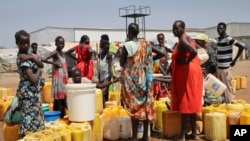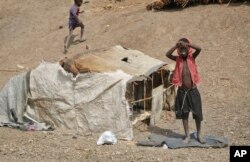Three leading United Nations agencies warn that more than half of South Sudan's population is suffering extreme hunger, and humanitarian aid is urgently needed.
Nearly 7 million people in the country could face severe food shortages at the peak of the lean season between May and July, according to a report released by the Food and Agriculture Organization, the U.N. Children's Fund and World Food Program, in collaboration with the government of South Sudan.
The lean season is a period of poor rainfall and little or no harvest, when food stocks are depleted and people often go hungry. Parts of the country that are at highest risk are the Greater Upper Nile, Bahr el Ghazal and Equatoria regions.
At the root of the hunger crisis is South Sudan's five-year civil war. But World Food Program spokesman Herve Verhoosel says a series of poor harvests and large-scale displacements, which prevent people from planting crops, are other factors contributing to the food shortages.
"Poor families in the worst-hit areas are already experiencing food gaps," Verhoosel said. "As many as 50,000 people will face famine-like conditions at the height of the lean season in July. ... Sixty percent of the population will be unsure where their next meal will come from."
WFP aims to provide food aid for 5.4 million people this year, requiring $662 million to cover the needs for the first six months, Verhoosel said. WFP still needs $145 million to meet this goal, he added.
U.N. agencies report malnutrition levels are critical in many areas, with some 860,000 children under the age of five severely malnourished. Acute malnutrition is expected to increase throughout the country during the coming lean season.

